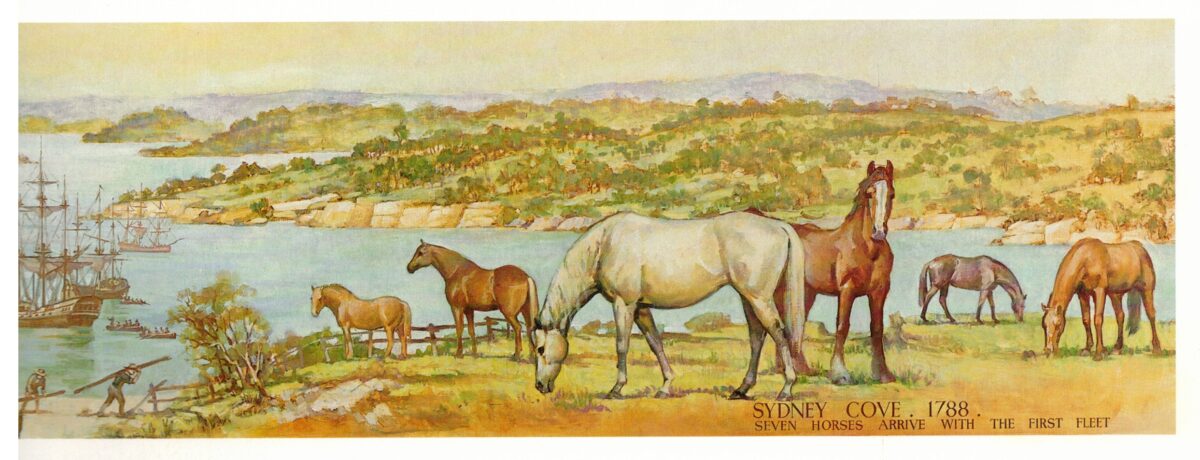Hunter Valley Pioneer Horsemen
Acknowledge “Horsemen of the First Frontier (1788 – 1900) and The Serpent’s Legacy” by Keith R. Binney, ISBN 0 646 44865 X.
I’m frequently asked why and how did the Upper Hunter Valley evolve and develop as the horse breeding centre of Australia, especially thoroughbreds? It’s an intricate issue with a few variants of interpretation.
Since British ‘settlement’ at Sydney Cove in 1788 the County of Cumberland was the only geographical region available for breeding of any livestock in the colony. For nigh on fifty years, it was the acknowledged supply depot for carriage, conveyance, and recreational horses so necessary as fast transport for advancement of the ‘developing’ infant colony. Indigenous Australians had successfully pursued their own pathways for over 50,000 years but neither horses nor any other beasts-of-burden had ever been part of the national landscape.
There were at least seven (7) horses on the first fleet, but these were rather cumbersome utility ‘Capers’ acquired while anchored in Cape Town, Cape of Good Hope, the penultimate destination of the First Fleet. See feigned ‘Featured Image’. They comprised one stallion, three mares and three foals (‘Colts’). Gradually over time superior horses were imported to improve the very basic genotype. They included Rockingham (1790s ‘Caper’), Northumberland (1801 ’Thoroughbred’), Shark (1801 Arab), Washington (1800 USA Thoroughbred) and Old Hector (Early 1800s ‘Thoroughbred’).
The redoubtable ‘Horsemen of the First Frontier’ in the County of Cumberland 1788 – 1860 incorporated Military Officers, Civil Officers, Merchants, First Free Settlers, Governors’ Families, Emancipists and Currency Lads. Included were such iconic surnames as Macarthur, Cox, Lawson, Bell, D’Arcy Wentworth, Piper, Grose, Rouse, Marsden, Oxley, Campbell, Badgery, Blaxland, Howe, Hall, King, Bligh, Rose, Lee and Thompson. The names of the early stud farm properties were no less striking. Elizabeth Farm, Camden Park House, Emu Hall, ‘Bungaribee’ (Eastern Creek) and Hobartville are no less firmly embedded in the psyche and ‘Colonial DNA’.
“Horsemen of the First Frontier (1788 – 1900) and The Serpent’s Legacy” by Keith R. Binney, ISBN 0 646 44865 X. The first wave of Free Settlers, together with some Emancipists and Currency Lads, in the Hunter Valley (Chapter Nine):
Henry Dangar and the Dangar Male Dynasty (1798 – 1861)
Thomas Potter Macqueen (1791 – 1854)
Peter Macintyre (1783 – 1842), John Macintyre and Donald Macintyre
Henry Dumaresq (1792 – 1838) and William John Dumaresq (1793 – 1869)
Robert Scott (799 – 1844) and Helenus Scott (1802 – 1879)
Henry Baldwin (c1770 – 1843), Otto Baldwin (1809 – 1894) and Charles Baldwin (1829 – 1906)
John Hooke (1789 – 1845) and Augustus Hooke (1865 – 1921)
George Bowman (1795 – 1878), George Pearce Bowman (1821 – 1870)
Alexander Bowman (1838 – 1892)
George Yeomans (c1801 – 1853) and Benjamin Singleton (1788 – 1853)
Edward Gostwyck Cory (1797 – 1873)
James Bowman (1784 – 1846)
Bourn Russell MLC (1794 – 1880)
James Glennie (1800 – 1876)
Robert Pringle (1800 – 1875)
George Townshend (1798 – 1972) (sometimes Townsend)
Thomas White Melville Winder (c1789 – 1853)
Henry Nowland (1796 – 1863)
John Galt Smith (1794 – 1847)
Henry Garrard (1808 – 1862)
Joseph Brown (1805 – 1862)
Thomas Jones (c1791 – 1864)
Richard Cornelious (or Cornelius) (c1809 – 1842)
Henry Reeves (1804 – 1852)
John Earl (c1790 – 1876)
Richard Harris
Thomas Valentine Bloomfield (1793 – 1857)
Edward Charles Close Jnr (1825 – 1887)
James Atkinson (1795 – 1834)
James H. Atkinson
Stephen Coxen (1798 – 1844)
Captain Edward Biddulph (c1790 – 1851)
Henry Eckford (c1805 – 1877)
Leigh Dines Halstead (c1802 – 1872)
Alexander McLeod (c1785 – )
See also:
Richard Jones, James Bettington, John & Gregory Blaxland, John Howe, Robert Lethbridge & Andrew Doyle
Limits of Location










